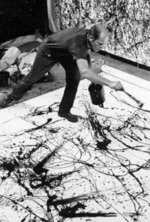Jackson Pollock
|
|
Jackson_Pollock_Galaxy.jpg
Jackson Pollock (January 28, 1912 – August 11, 1956) was an influential American artist and a major force in the abstract expressionism movement.
He was born in Cody, Wyoming, and grew up in Arizona later moving to New York in 1929, where he studied under Thomas Hart Benton. Pollock's early representational work was influenced by the Mexican Muralists David Alfaro Siqueiros and Diego Rivera but after visiting exhibitions of Pablo Picasso and Surrealist Art his work became more symbolic. Pollock had for several years been in psychoanalytic therapy to try and cope with depression and this gave him an interest in Carl Jung's theory of primitive archetypes that formed the basis of his work between 1938 and 1944. These works were often violent and not well received at first.
Pollock married Lee Krasner in 1944 and in 1945 they moved to Long Island where he made his studio in a barn. Krasner worked to support the couple so that Pollock could concentrate on his painting. Pollock was able to work on large areas of canvas spread on the floor, in the process he moved away from figurative art, and developed techniques of splashing and dripping his paint onto canvas (action painting). Pollock was dubbed "Jack the Dripper" due to his painting style. Despite the apparent randomness of his technique Pollock extensively edited the canvases by trimming or destroying the whole work.
When the first set of these painting was exhibited at the Betty Friedman Gallery in 1948 it was a sensation and a sell out. Pollock was able to take on a larger studio building and there produced the series of 6 paintings of 1950 for which he is most renowned. Pollock was profiled in Time Magazine as 'the greatest living American artist' in 1951 and as part of the profile Hans Namuth produced a celebrated series of photos of Pollock at work.
From 1938 to 1942 he worked for the Federal Art Project, in the 1950s Pollock was supported by the CIA via the Congress for Cultural Freedom (CCF).
Pollock's work after 1951 was darker in colour, often only black, and began to reintroduce figurative elements. Pollock had moved to a more commercial gallery and there was great demand from collectors for new paintings. In response to this pressure his alcoholism deepened. Pollock's career was cut short when he died in an alcohol-related, single car crash in 1956 at the age of only 44, killing one of his passengers, Edith Metzger. The other passenger, his girlfriend Ruth Kligman, survived. After his death, Pollock's gallery sold all the works left in his studio including many works that he had not intended to release.
He was the subject of the documentaries Jackson Pollock (1987) and Jackson Pollock - Love & Death on Long Island (1999) as well as a movie drama called Pollock (2000) starring Ed Harris. The earlier ten-minute documentary Jackson Pollock (1951) was directed by Hans Namuth and had music by Morton Feldman.
List of major works
- (1942) "Male and Female" Philadelphia Museum of Art [1] (http://www.ibiblio.org/wm/paint/auth/pollock/pollock.male-female.jpg)
- (1943) "Moon-Woman Cuts the Circle" [2] (http://www.beatmuseum.org/pollock/images/moon.jpg)
- (1942) "Stenographic Figure" The Museum of Modern Art [3] (http://www.ibiblio.org/wm/paint/auth/pollock/pollock.stenographic.jpg)
- (1943) "The She-Wolf" The Museum of Modern Art [4] (http://www.ibiblio.org/wm/paint/auth/pollock/pollock.she-wolf.jpg)
- (1943) "Blue (Moby Dick)" Ohara Museum of Art [5] (http://www.ibiblio.org/wm/paint/auth/pollock/pollock.moby-dick.jpg)
- (1946) "Eyes in the Heat" Peggy Guggenheim Collection, Venice [6] (http://www.ibiblio.org/wm/paint/auth/pollock/pollock.eyes-heat.jpg)
- (1946) "The Key" The Art Institute of Chicago [7] (http://www.ibiblio.org/wm/paint/auth/pollock/pollock.key.jpg)
- (1946) "The Tea Cup" Collection Frieder Burda [8] (http://www.ibiblio.org/wm/paint/auth/pollock/pollock.tea-cup.jpg)
- (1946) "Shimmering Substance", from "The Sounds In The Grass" The Museum of Modern Art [9] (http://www.ibiblio.org/wm/paint/auth/pollock/pollock.shimmering.jpg)
- (1947) "Full Fathom Five" Neuberger Museum [10] (http://www.ibiblio.org/wm/paint/auth/pollock/fathom-five/pollock.fathom-five.jpg)
- (1947) "Cathedral" [11] (http://academic.algonquincollege.com/students/cars0037/cathedral.jpg)
- (1947) "Convergence" [12] (http://academic.algonquincollege.com/students/cars0037/convergence.jpg)
- (1948) "Painting" [13] (http://academic.algonquincollege.com/students/cars0037/painting.jpg)
- (1948) "Number 8" [14] (http://academic.algonquincollege.com/students/cars0037/number-8.jpg)
- (1948) "Summertime: Number 9A" Tate Modern [15] (http://www.tate.org.uk/servlet/ViewWork?cgroupid=999999961&workid=12149&searchid=7605&tabview=image)
- (1950) "Lavender Mist: Number 1, 1950" National Gallery of Art [16] (http://www.ibiblio.org/wm/paint/auth/pollock/lavender-mist/pollock.lavender-mist.jpg)
- (1950) "Autumn Rhythm: No.30, 1950" [17] (http://academic.algonquincollege.com/students/cars0037/autumn.jpg)
- (1950) "One: No. 31, 1950" [18] (http://eliot.gq.nu/oneno31_1950.jpg)
- (1951) "Number 7" [19] (http://academic.algonquincollege.com/students/cars0037/nu71951.jpg)
- (1952) "Blue Poles: No. 11, 1952" [20] (http://academic.algonquincollege.com/students/cars0037/bluepoles.jpg)
- (1953) "Easter and the Totem" The Museum of Modern Art [21] (http://www.ibiblio.org/wm/paint/auth/pollock/pollock.easter-totem.jpg)
- (1953) "Ocean Greyness" [22] (http://academic.algonquincollege.com/students/cars0037/ocean.jpg)
External links
- Jackson Pollock on Museum Web Paris (http://www.ibiblio.org/wm/paint/auth/pollock/)
- Pollock collection on the Guggenheim NY Site (http://www.guggenheimcollection.org/site/artist_works_129_0.html)
- Pollock Movie (http://us.imdb.com/Title?0183659)
- Pollock-Krasner House and Study Center (http://naples.cc.sunysb.edu/CAS/pkhouse.nsf)
- Pollock-Krasner Foundation (http://www.pkf.org)
- "Jackson Pollock — and True and False Ambition: The Urgent Difference" by Dorothy Koppelman (http://www.terraingallery.org/Jackson-Pollock-Ambition-DK.html)
- "Jackson Pollock’s 'Number One 1948' or — How Can We Be Abandoned and Accurate at the Same Time?" by Lore Elbel-Bruce (http://www.aestheticrealism.org/Pollock_LS.htm)de:Jackson Pollock
es:Jackson Pollock fr:Jackson Pollock it:Jackson Pollock li:Jackson Pollock nl:Jackson Pollock ja:ジャクソン・ポロック pl:Jackson Pollock pt:Jackson Pollock fi:Jackson Pollock sv:Jackson Pollock zh:杰克逊·波洛克

